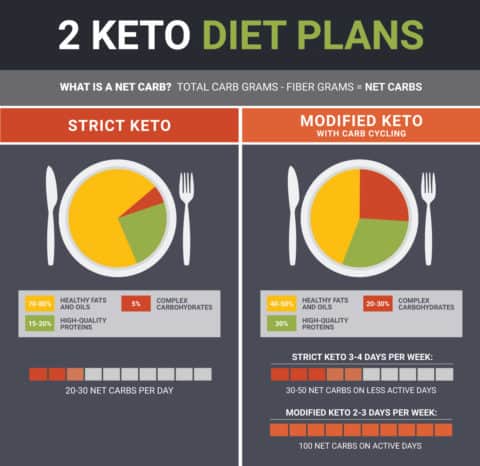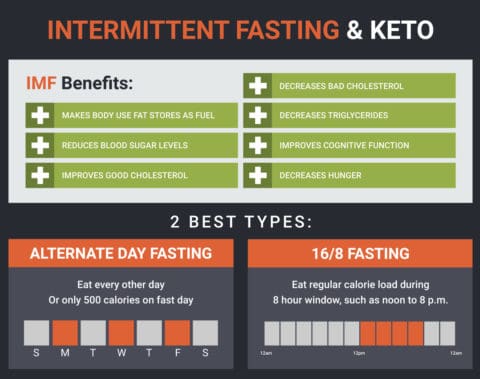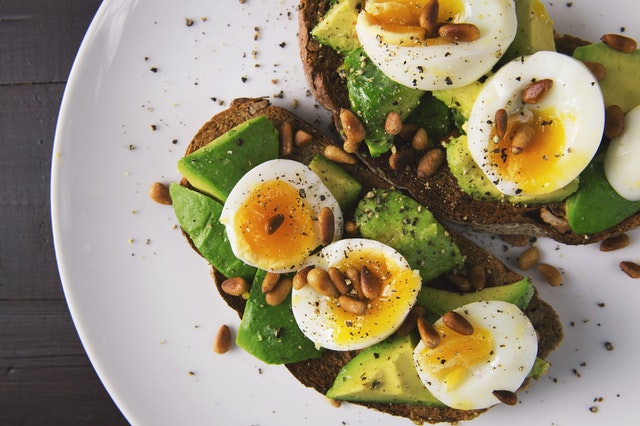
I’m usually introduced to my friends’ friends as “That Keto Weight Loss Gut Healthy Friend” when their friend shows interest in a dieting, digestive issues, or the ketogenic diet. I looove it and appreciate that my friends know that I love to share food stories!
A friend request is sent and accepted and our relationship starts out like this:
“Hi! A mutual friend connected us . I read through your post about being interested in keto. Personally, I love to eat and so I’ve done much research on having a healthy gut using real foods (hate to exercise but love the benefits…). I have a website where I share evidence-based research into healthy living and weight loss.
“Yes, for many people, a ketogenic diet is very doable. My husband was a critic about only eating 2-3 times a day as he’s always battled with low blood sugar levels. He didn’t think his body would be able to fast or adapt to much less eating. BUT! It completely stabilized his blood sugar levels and since the meals are still packed with nutrition, he just needs to eat all keto (ketogenic lifestyle) and he is totally fine eating two full meals each day! It’s crazy.”
Then, I chatter on about the biggest, most significant different between a low carb, high fat diet (#lchf) and the ketogenic diet. This is huge because it addresses what goes on inside the body-even on a cellular level.
“The big difference between keto and low carb is the percentage of healthy fats. Low carb diets and food recipes keep you around 45-65% healthy fats. It’s a good step but the actual production of “ketones for fuel” is not consistent enough for sustained weight loss or health benefits.
“The higher fat profile of a ketogenic diet is close to 80-85% healthy fat each meal! The ketones and stored body fat as fuel is actually therapeutic on a cellular level and specifically helps the liver as well as the digestive system. Your body isn’t put into the starvation mode at all despite the smaller eating window and slightly less calories (usually meals are around 1300 calories). So the losses and changes that your body goes through-esp in the first two months-won’t be creating stress ( which always translates into inflammation which means stored fat) in your body, allowing it to heal and repair any nutritional deficiencies.
“Your blood sugar levels will balance, natural hormone cycles and levels will be re-established (which control every aspect of your body’s functions), and any food cravings will literally disappear! Since I was a huge sugar addict, I’ve learned to make the sugar alcohol sweetened desserts (monk fruit is the BEST) which are high in collagen/gelatin for the added benefit of healing the gut lining) so that I don’t start to crave again. You have to find what flavors and foods you enjoy and make sure you add them in a healthy way!”
I’d say that most people who are interested in the ketogenic diet have a long past of carbohydrate and sugar consumption, which is sooo damaging to the whole body: intense cravings, emotional instability, nutrient deficiencies and poor absorption, brain fog, headaches, poor sleep, leaky gut lining, damaged dopamine reward system, and probably some skin issues.
By the time serious consideration of a ketogenic diet is vocalized, most have been given a diagnosis of thyroid issues or an autoimmune disease that is impacting their quality of daily life.
I’ve been there so I understand how needing to make a full out switch becomes a necessity, not just for a healthy weight. Damned if you do, damned if you don’t.
Simplicity.
I am a huge fan of keeping life simple to avoid being even more obsessed about food, meal plans, and quick options. The Reset Your Weight {Basics} motto: Be obsessed with life, not the weight of food!
Since I’m not really convincing people that their body would do well on a ketogenic diet (unless… read this summarizing post for who should not consider a keto diet), I share the two simple ways of starting a ketogenic diet.
1: Tracking
Track your macro and micro nutrients (what’s this?) so you stay in the (therapeutic) zone. Read up on some great posts explaining what you’re doing:
Ketogasm: What are Macros
RuledMe: Macronutrients and the ketogenic diet
The Keto Summit: Keto Diet Food List: 221 Foods to Boost Energy (+ Printable Cheat Sheet)
Dr. Axe: Keto Diet
Become familiar with the ketogenic food pyramid and common food choices:

Know your “foods to (always) avoid:”

Download a tracker and make tweaks to your nutrients and meals as you go:
2. Ketogenic Cookbooks
Define Your Ketosis Target
By purchasing or using recipes online from authors who are ketogenic-not simply low carb, this makes it very easy to “stay in ketosis” without the math required in method #1. Most recipes list the nutrient profile of the meal, so you can see how it compares to your personal targets.
I really like this simple estimator for nutrient ratios from Maria Emmerich, international best seller of many ketogenic cookbooks, as a simple way to define your ketosis range:
Knowing your target range will help you to choose recipes that meet your body’s needs. For instance, I like many of the recipes from I Breathe I’m Hungry, but I know to make her desserts more sparingly as she uses more almond flour and such in those recipes. She has amazing recipes for both low carb and ketogenic eating.
Identify Your Flavor Profile #findyourflavor
Do you like seafood? Like to eat more plant based proteins over (clean) animal protein? Do you absolutely need to be dairy free (eliminating this is beneficial for everyone) so that you are not triggering reactions and inflammation? Or is anything with bacon a guaranteed all good?!
Desserts: are you hard core sugar and the thought of stevia leaves you with an unpleasant aftertaste? You’ll want to find recipes that use monk fruit or a monk fruit blend as opposed to stevia and Swerve.

I suggest you head to a well-stocked bookstore, find the cookbook section, and flip through all the books. Find at least one cookbook that uses ingredients you commonly have in your fridge and pantry, enjoy similar dishes at home and at restaurants, and get you excited to be cooking. Because you’ll be cooking no matter what book or method you choose
Not really into cooking your own food? Find recipes that are done in under 30 minutes. Find a cookbook where they incorporate weekly meal prep into one day of chopping, shopping, and storing. Find a friend to join you and split the cooking (make a double recipe and store the rest).
Seriously don’t want to cook? Check out this great review post by Wicked Stuffed, 10 Low Carb Meal Delivery Services Reviewed. Again, low carb- not necessarily ketogenic. Ketoned Bodies may be available!
“I like using a cookbook designed for ketosis because then I don’t have to “count” or watch my ratios. Just eat.”
Recommendations
Check out these websites for their recipes. Many of them have cookbooks if you start pinning their recipes. Just remember to differentiate between low carb cookbooks and recipes from ketogenic. It matters to what is going on inside your body so that the weight doesn’t pile back on 6 months to a year later.
Strictly Keto:
Maria Emmerich: Keto Adapted
Grass Fed Girl (Keto section)
Both Low Carb and Keto:
Peace Love and Low Carb Kydra Holley is awesome on IG!
Eat Well + Lose Weight + Heal Your Body
Personally, I love Maria Emmerich’s cookbooks. All the recipes are familiar to me while still giving a variety of flavor options (Keto Restaurant Favorites) and many of them are either dairy free or have alternative ingredients. They are on the table in less than 30 minutes and require very little prep work. She provides meal plans with color photos for each meal, complete with shopping lists. No brain processing required to stick to the keto plan!
One of the major reasons I like her cookbooks is that her recipes are gut friendly:
“I also like her recipes because she incorporates gut healing and gut friendly foods like bone broth and fresh, prebiotic foods. So her meals are not only keeping you in ketosis, but healing your leaky gut or any digestive issues.”
Unless you heal your gut, the symptoms of your root issues won’t be addressed and the weight will be harder to manage. Read more about the 3 Causes of Stubborn Weight. Identify your root cause for why you battle with weight issues so you can target foods that will heal and nourish your body.
While the majority of your macros will come from high fat, moderate protein, and less carbs, don’t overlook nutrient density and the quality of the food source.
What To Do After… Do I Always Have to Eat Keto?
This question always comes up! Personally, it wasn’t until I stopped eating ketogenic meals and ventured off on my own that I realized a ketogenic lifestyle is my best option for health, weight management, and daily balance. My body struggles when I eat too many carbs. The pull toward quick desserts with refined flours and sugar when I’m stressed just catapult me into a crazy eating frenzy all too easily.
Low Carb Transitions
You may decide to start with a low carb diet plan or ratios. Since most eat way more carbohydrates and hidden sugar than you are aware of, this transition approach is great for working out your food cravings and identifying comfort foods.
With this approach, you can make eliminations and swaps without the mental stress or being “out of ketosis” and the time it takes to get back into creating ketones (because it’s not an easy flip flop).
Swap your oils to the healthy, saturated fats and find high fat sauces to pour over your meals to boost fat intake. Eat more veggies. Fill your cart with common keto ingredients that you can’t find at the local grocery store like gelatin, pure sweetener, protein powder, and pysllium husk.
Carb Cycling Options and Intermittent Fasting
Health issues aside, if you are just choosing a ketogenic diet for weight loss, Dr. Axe explains:
“Most adults find weight loss success with a more moderate approach to the low-carbohydrate ketogenic diet, simply by focusing on eliminating carbohydrates and increasing calories from healthy fats and protein. (In fact, many will experience weight loss by just reducing carbohydrates to 30 percent of their total calorie intake, while increasing fat and protein to 40 percent and 30 percent respectively.”
The best food plan to cycle with the ketogenic diet is the Mediterranean diet. Healthful Pursuit’s interview is on point:
For instance, if you are dealing with out of whack cortisol levels, then you may do better with a touch more carbs in the evening. Depending on your tastes and what your body needs, these carbohydrates may be from nuts and seeds, or maybe from a starchy veggies like a half of sweet potato.
If you decide to cycle, I recommend setting a limit on the length of time or using an intermittent fasting type so that you don’t stray too far from producing ketones on a regular basis for the therapeutic and weight benefits. Long term sugar addict like myself? Stay sensitive to the changes and cravings.


What other cookbooks could you look into during a cycle? Check out this illustration of the differences between 5 great healthy eating plans by Paleo Treats:

Reset Your Weight {Basics}
I hope this helped clarify the difference between a low carb and a ketogenic diet, how to transition into a ketogenic diet, and what most people do with their overall relationship with food. Need daily inspiration? Follow me on Instagram!
OnKeto.com is a news aggregation service that brings you best of world articles to you for your consumption.
Author: None
Author URL: None
Original Article Location: http://www.resetyourweightbasics.com/ketogenic-diet/
